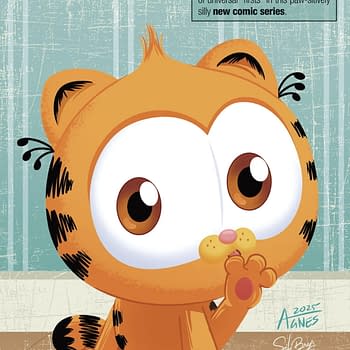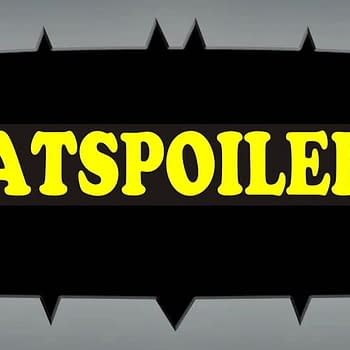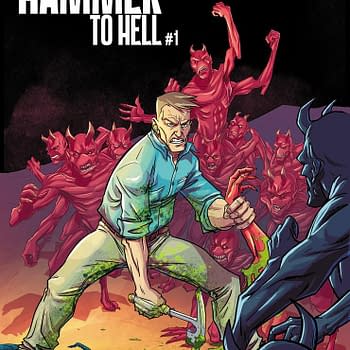Posted in: Comics | Tagged: dc, jh williams iii, john bultena, sandman, The Sandman Overture
Raw Sandman Art And How The Hell Are We Going To Read Promethea? JH Williams Is All That Rock And Roll At SDCC
John Bultena really put J. H. Williams III through his paces in his spotlight panel on Thursday at SDCC, covering vast territory in the creator's thoughts and influences, not to mention current and upcoming projects, but Williams amiably fielded the questions with rapid-fire explanations and even a degree of exuberance. Bultena titled the discussion "It ain't all Rock and Roll", meaning there was plenty of hard work behind Williams' vast and varied output, but much of the panel revealed that Williams continues to rock and roll at an unflagging pace creatively. For Williams, it certainly seems that he is just where he wants to be creatively and the works he previewed only gain ground in their breadth, scope, and experimentation.
Bultena pointed out what every die-hard Williams fan knows, that he's worked with so many big names in the industry that it's become a check-list of the good and the great, from Grant Morrison, to Alan Moore, and now Neil Gaiman in the upcoming Sandman: Overture being so heavily discussed at SDCC. First up Bultena tackled Williams' influences as an artist with accompanying illustrative slides which provided a lot of in-depth discussion about page layouts, something dear to Williams' heart. Michael Golden was one of Williams' earliest loves, discovering his Micronauts on a convenience store spinner as a kid, which led onward and upward into the world of comics. Discovering a single Golden comic changed Williams' life and led to an early decision to pursue the career of a comics artist.


But, of course, fans were waiting in the hopes that they'd see some work from Sandman: Overture, and he didn't disappoint. He added to the spectacle by providing images for Batwoman #22, which had come out this week, and also from Batwoman #23 in preview. It was heady stuff, and it's fair to say the art he previewed went well beyond expectations fans might hold of exactly what makes J. H. Williams art so recognizable. Each showed signs of moving clearly and confidently beyond the artist's comfort zones into purely new territory. Batwoman #23's cover depicts a nightmare dream sequence, and Williams was "surprised" it was approved by DC since it didn't feature Batwoman recognizably enough in favor of a more avant garde design bathed in a sea of blood. He hinted that the upcoming Batwoman #24 will bring out more decisive conflict between Batwoman and Batman, including a "face-off" that culminates in a battle scene so extreme that it couldn't be contained in a single issue.
But the "raw art" Williams shared on Sandman: Overture was astonishing enough to reduce fans to stunned silence followed by unanimous applause. The look and feel of the cover art contains "sci-fi" elements that hark back to pulp novels, and bring us a different Sandman than we've ever seen on cover art before, such as Dream in his "helm", rendering him more alien in appearance. He was "happy" with the outcome, he said, and he's "rarely happy" with anything he does, he's so exacting. He revealed black and white images from the interior of pages 2 and 3 of issue #1, and then displayed the overlay of Dave Stewart's colors rendering the images even more alien and inviting in exotic tones, including a dominating theme of flowers and plants in the first "chapter" of the work.
Unsurprisingly, Williams fielded a first question from fans about his layouts and his interaction with iconic writers. He compared three writers he's worked with in their differing expectations about degree of planning and control over artwork. Working with Alan Moore on Promethea became a process of actually influencing Moore's scripting as he began to see what Williams was capable of in pushing the visual envelope, leading to a 50-50 split in input by the end of the series, whereas Grant Morrison provided some layouts but discussing 7 Soldiers extensively actually led to changes in the script as it was being produced to suit visual experimentation. Gaiman, however, simply "trusts" Williams and leaves him to "do what he wants to do", including expanding pages by double when necessary. Williams finds that trust "gratifying".
Q&A led to one of Williams' more surprising statements in the panel, something of a gift to fans, the explanation that the upcoming "widescreen" Promethea volume 1 being produced at the moment will be twice as wide in dimension as the normal absolute editions, and also a presentation of issue #12 like it's never been seen before, but was originally planned. #12 will consist of "one long panoramic panel" that extends 16 feet long in a fold-out. More stunned silence followed as the audience tried to imagine experiencing such a thing before thunderous applause.
Williams' final thoughts of the panel were that he conceives of design elements as a "gut response instead of an analytical one" and that this fact leads to his extreme enthusiasm over Sandman: Overture where he feels like he gets to play with "epic scale" in his designs. It really "lends itself" to being "superimaginative", he said, in how a story can be told. But before his packed panel could file out of the room, Williams had a request- he kept fans in their seats long enough to take a picture of them all to capture as a memory of his own. That seemed like the actions of a comic creator excited to be at a point in his career when he can push boundaries, turn around and find the support of fans clamouring to encourage the experimentation and the new reach he continues to prove comic art can achieve.
Hannah Means-Shannon writes and blogs about comics for TRIP CITY and Sequart.org and is currently working on books about Neil Gaiman and Alan Moore for Sequart. She is @hannahmenzies on Twitter and hannahmenziesblog on WordPress. Find her bio here.














